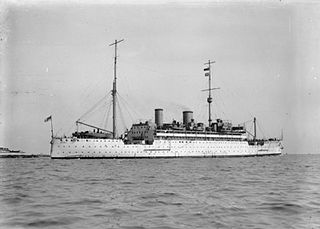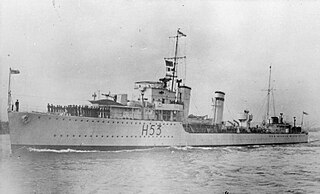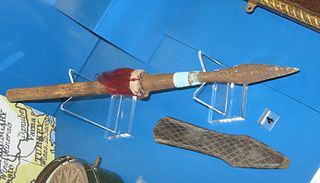
HMS Hampshire was one of six Devonshire-class armoured cruisers built for the Royal Navy in the first decade of the 20th century. She was assigned to the 1st Cruiser Squadron of the Channel Fleet upon completion. After a refit, she was assigned to the reserve Third Fleet in 1909 before going to the Mediterranean Fleet in 1911. She was transferred to the China Station in 1912 and remained there until the start of the First World War in August 1914.

HMS Thetis (N25) was a Group 1 T-class submarine of the Royal Navy which sank during sea trials in Liverpool Bay, England on 1 June 1939. After being salvaged and repaired, the boat was recommissioned as HMS Thunderbolt in 1940. It served during the Second World War until being lost with all hands in the Mediterranean on 14 March 1943.

A ship is scuttled when its crew deliberately sinks it, typically by opening holes in its hull.
Poseidon is the god of the sea in ancient Greek mythology.

Dingyuan was an ironclad battleship and the flagship of the Chinese Beiyang Fleet. She was the lead ship of the Dingyuan class, which included one other vessel, Zhenyuan, both of which were built in Germany in the early 1880s. Delivery of the two ironclads was delayed by the Sino-French War of 1884–1885. The ships were armed with a main battery of four 12 in (305 mm) guns in a pair of gun turrets, making them the most powerful warships in East Asian waters at the time.

Liugong Island is a small island located on the northeastern edge of Shandong Peninsula, China, at the mouth of Weihai Bay. It is known as the "birthplace of China's first modern navy" and is also the site of its defeat in the First Sino-Japanese War.

HMS Aurora was an Arethusa-class light cruiser of the Royal Navy. She was built by Portsmouth Dockyard, with the keel being laid down on 27 July 1935. She was launched on 20 August 1936, and commissioned 12 November 1937.

The Parthian-class submarine or P class was a class of six submarines built for the Royal Navy in the late 1920s. They were designed as long-range patrol submarines for the Far East. These boats were almost identical to the Odin class, the only difference being a different bow shape.

HMS Medway was the first purpose-built submarine depot ship constructed for the Royal Navy. She was built by Vickers Armstrong at Barrow-in-Furness during the late 1920s. The ship served on the China Station before the Second World War and was transferred to Egypt in early 1940. Ordered to evacuate Alexandria in the face of the German advance after the Battle of Gazala in May 1942, Medway sailed for Lebanon at the end of June, escorted by a light cruiser and seven destroyers. Her strong escort could not protect her; on 30 June a German submarine torpedoed and sank her.
HMS Marazion was a Hunt-class minesweeper launched by Fleming & Ferguson, Paisley, Yard No 453, on 15 April 1919 and sold in March 1933 in Hong Kong.

USS Fulton (AS-1) was constructed as a submarine tender in 1914, but later was converted into a gunboat and redesignated PG-49.

HMS Edgar was a first class cruiser of the Royal Navy, and lead ship of the Edgar class. She was built at Devonport and launched on 24 November 1890. She served on the China Station, and in the First World War in the Gallipoli Campaign, along with her sisters Endymion, Grafton and Theseus.

HMS Dainty was a D-class destroyer built for the Royal Navy in the early 1930s. The ship was initially assigned to the Mediterranean Fleet before she was transferred to the China Station in early 1935. She was temporarily deployed in the Red Sea during late 1935 during the Abyssinia Crisis, before returning to her assigned station where she remained until mid-1939. Dainty was transferred back to the Mediterranean Fleet just before World War II began in September 1939. She briefly was assigned to West Africa for convoy escort duties in 1940 before returning to the Mediterranean. The ship participated in the Battle of Calabria in July 1940 and was assigned to convoy escort and patrol duties until she was sunk by German bombers off Tobruk on 24 February 1941.

HMS Vulcan was a British torpedo boat depot ship launched in 1889, later converted to a submarine tender in 1908-09. As a training hulk, she was renamed HMS Defiance III in 1931 and used for training at Torpoint, Cornwall. She was scrapped in Belgium in 1955.

HMS Pandora was a British Parthian-class submarine commissioned in 1930 and lost in 1942 during the Second World War. This class was the first to be fitted with Mark VIII torpedoes. On 4 July 1940 she torpedoed and sank the French aviso Rigault de Genouilly off the Algerian coast. In an extension of the Lend-Lease program, Pandora, along with three other British and French submarines, was overhauled at Portsmouth Naval Shipyard in the United States. She was sunk on 1 April 1942 by Junkers Ju 87 aircraft from Sturzkampfgeschwader 3 at the Valletta dockyard, Malta.

The Irene incident was a 1927 British anti-piracy operation in China. In an attempt to surprise the pirates of Bias Bay about sixty miles from British Hong Kong, Royal Navy submarines attacked the steamship SS Irene, of the China Merchants Steam Navigation Company, which had been taken over by the pirates on the night of 19 October. The British were successful in thwarting the hijacking though they sank the ship.

The Poseidon Project is a 2013 documentary film about the search for the lost Royal Navy submarine HMS Poseidon. The submarine sank after a collision off the coast of China in 1931. It was widely assumed to be still present in the Bohai Sea, 20 miles off the city of Weihai in China's Shandong Province until American author and scuba diver Steven Schwankert discovered that she had been salvaged by a Chinese salvage team in 1972. Schwankert's work and the history of the submarine and its crew is the subject of The Poseidon Project. The film was directed by British brothers Arthur Jones and Luther Jones.

Arthur Benjamin Jones is a British film director and producer.
















